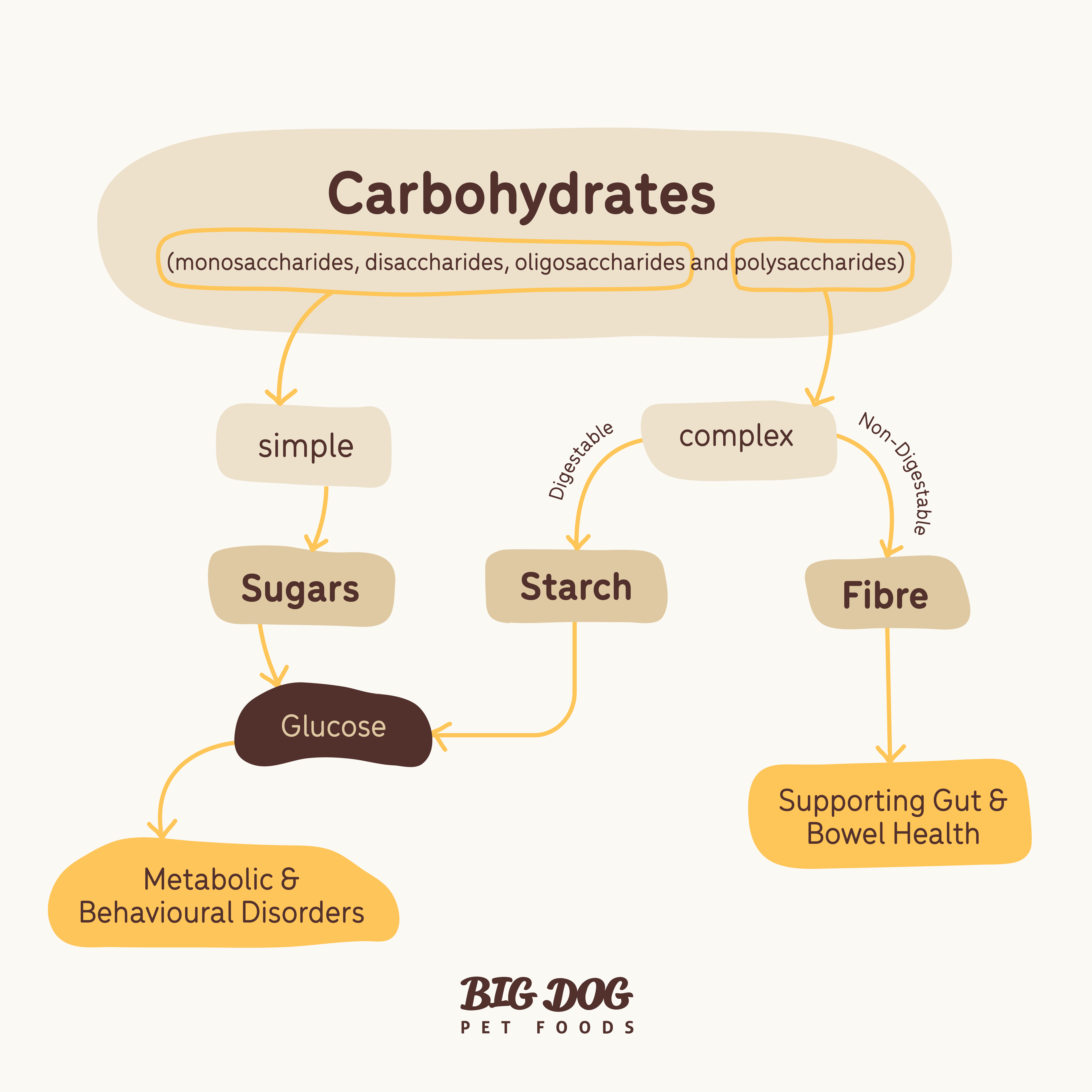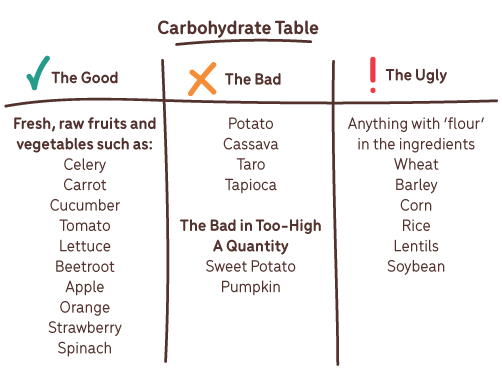Hidden Sugars in Commercial Pet Foods

by Narelle Cooke, Canine Nutritionist

Of all the nutrients, carbohydrates seem to be among the most misunderstood and, when it comes to our dogs, the topic of how much carbohydrate we should be feeding them is often highly divisive!
‘Carbohydrate’ is an umbrella term for a range of different monosaccharide’s, disaccharides, oligosaccharides and polysaccharides. But to keep things simple, we can classify them into three main subgroups: sugars, starches and fibre, each of which have their own unique chemical structure. Simple sugars, such as glucose, require little digestion and enter the bloodstream very quickly. This causes rapid rises and falls in a dogs’ blood glucose and insulin levels which can, in some instances, contribute to certain metabolic and behavioural disorders (1). Starches have a more complex structure to begin with as compared to simple sugars, but are also ultimately broken down to provide glucose, with similar health consequences if fed in excess. Fibre, on the other hand, is a non-digestible (non-starchy) form of carbohydrate that’s found in plants. Unlike starch, fibre isn’t broken down into glucose, and plays an important role in supporting gut and bowel health.

What you may be surprised to learn is that technically, dogs don’t have any requirement for carbohydrates in the same way that they need protein and fats to survive and yet, it forms the major part of the typical pet dogs’ diet. If we consider what a wolf might have consumed in the wild, the carbohydrate content is estimated to have been around 1% of the total diet (2), and studies done on domestic pet dogs show that when given a choice, they will select a diet that’s around 7% carbohydrate (3). Such findings are in alignment with formulated raw foods such as the Big Dog patties which contain a carbohydrate content of between 3-7% on a dry matter basis, but is in stark contrast to the average commercial kibble product which contains a carbohydrate content of between 30-60%!

I’m personally not anti-carbohydrate when it comes to my own diet or that of my dogs, but the point I want to get across today is that there are huge differences between the various types of dietary carbohydrates in terms of their impact on health and disease. Let’s think of them as the good, the bad and the ugly!
The Good
Fresh fruits and aboveground vegetables predominantly contain non-starchy carbohydrates (or very low levels) and are rich sources of phytonutrients and fibre. In recent years, there has been an explosion in research highlighting the potential role of dietary phytonutrients from plants in the promotion of health and in the prevention of chronic diseases. And while phytonutrients are not essential to keep your dog alive, it is widely accepted that the consumption of such natural compounds confers protection against oxidative stress, inflammation, vascular dysfunction and metabolic dysregulation, thus reducing several risk factors for a range of different pathological states including obesity, diabetes, cardiovascular and neurological diseases and certain types of cancer (4). Phytonutrients also enhance immunity and intercellular communication, repair DNA damage from exposure to toxins, detoxify carcinogens, balance hormone metabolism, and provide increased benefits to mood, cognitive function and performance (5,6).
You’ll tend to see more of these low and non-starchy carbohydrates added to high quality raw foods brands such as Big Dog because of the benefits they provide to our dog’s digestive and immune systems, as well as for improving overall wellbeing.

The Bad
Increased levels of starchy carbohydrates are found in root vegetables such as potato, sweet potato, cassava (tapioca), and taro. So just because a kibble claims to be ‘grain-free’, it in no way means that it doesn’t contain high levels of carbohydrate – they often contain even more! And remember, these starches are broken down into sugar in the body.
There are times when small amounts of starchy carbohydrates can provide benefits to our dogs, for example, in the treatment of diarrhoea, or when energy needs are high, such as during growth, gestation and lactation. But like us, only a limited amount of carbohydrate can be stored in the body at any one time, so when dogs consume carbohydrates in excess of their body’s energy needs, most will be converted to body fat and stored.
Because dogs are now consuming excessive amounts of carbohydrates (aka sugar) in their diets as a result of eating kibble-rich diets, we’re seeing a significant increase in obesity in dogs in addition to diseases that occur as a result of obesity, such as diabetes and heart disease. Excess sugar also contributes to increased cancer risk, allergies, and yeast infections. So for pet owners whose dogs are constantly struggling with yeasty ear infections, problem skin conditions, or weight issues, it’s important to look at how much carbohydrate is actually in your dog’s diet that may be fuelling the problem.
Unfortunately, determining the amount of carbohydrate in your dog’s diet isn’t straightforward because unlike human foods, manufacturers are not required to list carbohydrates on the label - but it’s easy once you know how.

The Ugly
Starch is also the main type of carbohydrate found in cereal and legume grain crops such as wheat, barley, corn, rice, lentils and soy. And while such ingredients are not at all species appropriate for our dogs, a mixture of these different grains will often make up the largest proportion of a standard commercial kibble formula. There are several reasons for why this is the case:
· Carbohydrates from grains are cheap for manufacturing companies to purchase and as such, are used to bulk up a kibble formula.
· Grain crops also provide a source of protein, and using soybeans, for example, to boost the protein content of a kibble is a lot cheaper than using an animal protein such as beef, venison, lamb, goat or salmon. However, studies have shown that grains have an inflammatory effect in our dogs and increase markers of oxidative and metabolic stress. Unfortunately, low-grade inflammation is often not apparent in the short term, but when foods that trigger inflammation are fed over a period of years, that’s when you’ll see an increase in degenerative diseases, including cancer (7).
· The other main reason that starch is so high in standard kibble formulas is because to make kibble, it has to go through what’s called an extrusion process. At a very basic level, what happens during extrusion is that all of the ingredients needed to make a kibble are mixed together to form a dough, which is then pushed through a giant metal screw under intense heat and pressure before finally being pushed out through a small opening at the end where it can be cut into the shapes we see in the kibble packets. But for the extrusion process to work it needs starch – a minimum of about 30%. It’s the starch that makes the dough sticky and which acts like a ‘cement’ to hold all of the ingredients together.
Of even lesser value are grains that have been milled (referred to as ‘refined’ grains), a process that removes the bran and germ. Refined grains contain the same number of calories as the wholegrain but provide almost no nutritional value, as the milling process removes key vitamins and minerals.
How to determine the carbohydrate content of commercial dog food
Carbohydrates are not measured directly, so you won’t see them listed on the label, but we can estimate them by subtracting the key information on the guaranteed analysis located on the pet food packet from 100. Often a company won’t list the ‘ash’ value, but the general estimate for a kibble is between 5-8%(I’ll use 7% in my calculations). Moist foods have lower ash values, usually around 2-3%. Some equations include fibre and some don’t. Because fibre is indigestible, it doesn’t really matter which approach you take as long as you’re consistent.
Guaranteed analyses are expressed on an “as fed” basis. However, to accurately determine what our dogs are eating, it’s important to convert these guarantees to a dry matter basis when comparing foods with differing moisture content (e.g., raw vs. dry foods).
Example
Popular commercial kibble product
Percent carbohydrate (as fed) = 100 - % protein - % fat – fibre - % moisture - % ash
= 100 – 27 – 12 – 4 – 12 – 7
= 38.0 % carbohydrate
But once we take out the moisture:
Percent carbohydrate (DM) = [Percent carbohydrate (as fed) ÷ (100 –moisture)] x 100
= [38.0 % ÷ 88] x 100
= 43.2 % carbohydrate
Big Dog Raw Dog Food
Percent carbohydrate (as fed) = 100 - % protein - % fat – fibre - % moisture - % ash
= 100 – 13.0 – 13.7 – 1 – 69 – 2.4
= 0.9 % carbohydrate
Percent carbohydrate (DM) = [Percent carbohydrate ÷ (100 –moisture)] x 100
= [0.9 % ÷ 31] x 100
= 2.9 % carbohydrate

The same principles can be applied to other nutrients in our dog’s food in terms of converting them from ‘as fed’ to a ‘dry matter’ basis. For example, it may appear that the kibble is much higher in protein than the raw food, but once the moisture is removed, this is the more accurate representation of what your dog is eating.
References
1. Dodds,W.J., Nutrition and Thyroid FunctionAffect Canine Behavior and Cognition. In: Dog Symposium. 2016: Olso, Norway.
2. Bosch,G., Hagen-Plantinga, E.A., et al., Dietary nutrient profiles of wild wolves:insights for optimal dog nutrition? Br JNutr, 2015(113): p. S40-54.
3. Roberts,M.T., Bermingham, E.N., et al., Macronutrient intake of dogs, self-selecting diets varying in composition offered ad libitum. J Anim Physiol Anim Nutr 2018.102(2): p. 568-575.
4. Giampieri,F., Special Issue "Phytochemicals in Health and Disease". Nutrients,2018.
5. Spencer,S., Layé, S., et al., Food for thought: how nutrition impacts cognition and emotion. NJP J Sci Food, 2017. 1(7):p. 1-8.
6. Gupta,C. and Prof, D., Phytonutrients as therapeutic agents. J Complement. Integr. Med,2014. 11(3): p. 151-169.
7. Gentzel,J.B., Does contemporary canine diet causes cancer? A review. Veterinary World, 2013:p. 632-639.
About the Author - Narelle Cooke, Canine Nutritionist.

Narelle is a clinical Naturopath, Nutritionist and Herbalist for both people and pets, and operates her wellness clinic ‘Natural Health and Nutrition’ in Dural, Sydney.
Being a lifelong dog-owner and currently meeting the demands of three French Bulldogs, two German Shepherds and a Burmese cat, Narelle is as passionate about the health and wellbeing of our pets as she is about their owners. And it was this strong desire to see her own pets live their longest and best lives that led her to hours of personal research and additional study in the area of natural animal health and nutrition.
· Bachelor of Health Science(Naturopathy) (ACNT)
· Bachelor of Agricultural Science (honours) (The University of Melbourne)
· Advanced Diploma of Naturopathy (AIAS)
· Advanced Diploma of Nutritional Medicine (AIAS)
· Advanced Diploma of Western Herbal Medicine (AIAS)
· Certificate III in Dog Behaviour and Training (NDTF)
· Certificate in Natural Animal Nutrition (CIVT)
· Certificate in Animal Nutrition (HATO)
